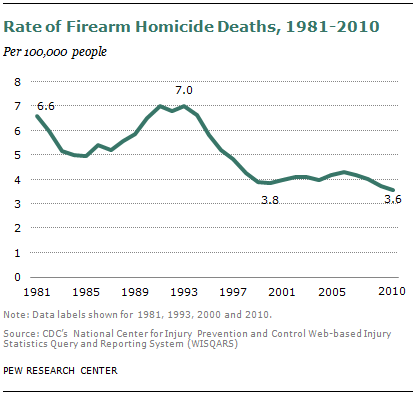You couldn’t tell it by the vigor of the public debate but the rate of homicides with guns in the United States has dropped rather dramatically from the ’90s, an analysis of government data shows today.
The Pew Research Center study shows the homicide rate has been cut in half from the early ’90s, but there’s a big caveat: Most of the decline took place in the ’90s.
Compared with 1993, the peak of U.S. gun homicides, the firearm homicide rate was 49% lower in 2010, and there were fewer deaths, even though the nation’s population grew. The victimization rate for other violent crimes with a firearm–assaults, robberies and sex crimes–was 75% lower in 2011 than in 1993. Violent non-fatal crime victimization overall (with or without a firearm) also is down markedly (72%) over two decades.
Nearly all the decline in the firearm homicide rate took place in the 1990s; the downward trend stopped in 2001 and resumed slowly in 2007. The victimization rate for other gun crimes plunged in the 1990s, then declined more slowly from 2000 to 2008. The rate appears to be higher in 2011 compared with 2008, but the increase is not statistically significant. Violent non-fatal crime victimization overall also dropped in the 1990s before declining more slowly from 2000 to 2010, then ticked up in 2011
Despite the reality, 56 percent of those surveyed think that gun homicides are up.

What’s responsible for the drop? The outsized post-World War II baby boom, which produced a large number of people in the high-crime ages of 15 to 20 in the 1960s and 1970s, helped drive crime up in those years, Pew says.
One other surprising statistic: The rate of suicides with guns is higher than the rate of homicides by gun.
Don’t wait for the news coverage to be adjusted accordingly on that one.
